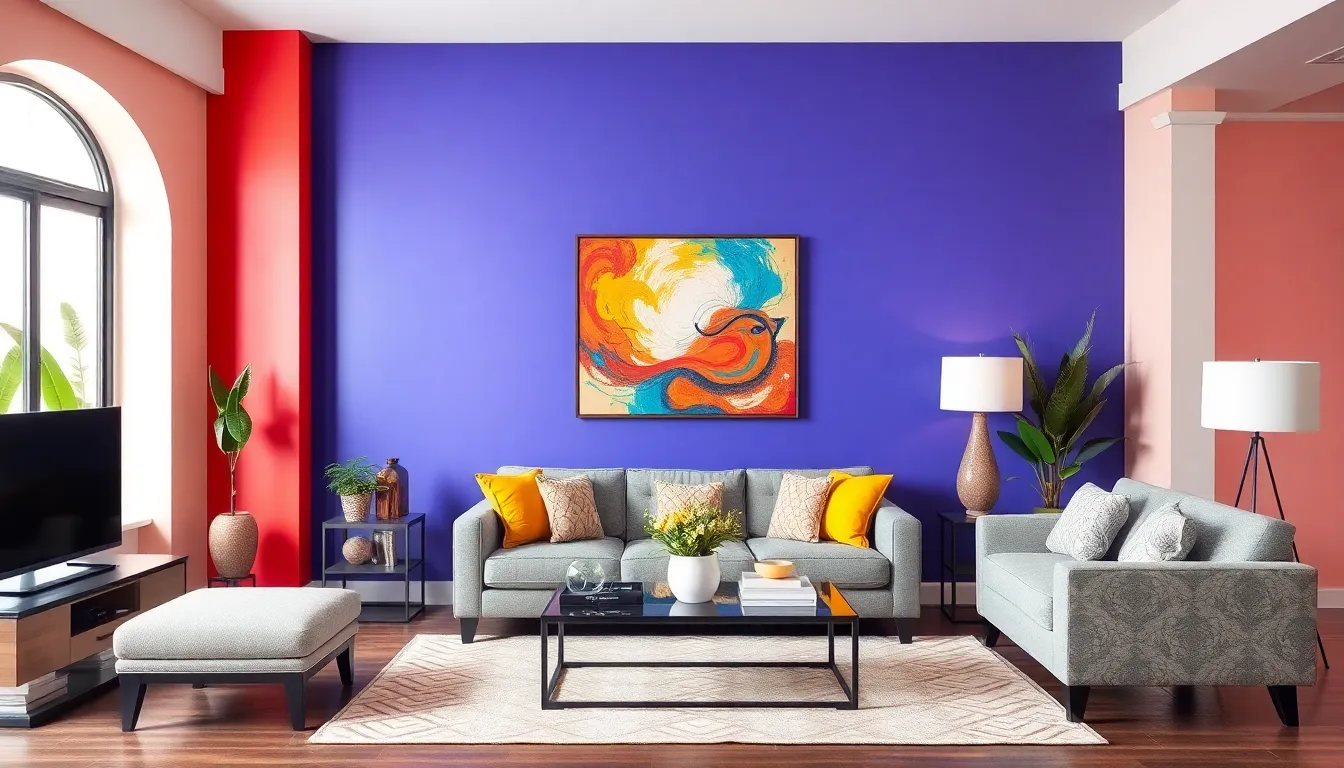Imagine walking into a room where one wall boldly declares, “Look at me!” That’s the magic of accent walls. They’re like the cool friend who shows up to the party wearing a flashy outfit, effortlessly stealing the spotlight. With just a splash of color or a daring pattern, an accent wall can transform any space from drab to fab faster than you can say “interior design.”
Whether it’s a vibrant hue that energizes the room or a subtle texture that adds depth, accent walls are the secret weapon every homeowner needs. They’re not just trendy; they’re a canvas for creativity. So why settle for plain when you can have a statement? Dive into the world of accent walls and discover how to unleash your inner designer while keeping your space stylish and unique.
Table of Contents
ToggleWhat Are Accent Walls?
Accent walls serve as a focal point in a room, drawing attention and creating visual interest. Typically, one wall stands out through the use of bold colors, unique patterns, or different textures. This design strategy enhances the overall aesthetic without overwhelming the space.
Many homeowners choose paint, wallpaper, or even wood paneling for their accent walls. A striking color can invigorate a dull room, while a textured surface can add depth and warmth. This versatility allows anyone to customize their environment according to personal style.
For instance, a vibrant red or a deep blue can bring energy to a living area. Soft pastels or neutrals might create a calming retreat in a bedroom. Each choice influences the room’s atmosphere, impacting how one feels in the space.
In addition to color, patterns also play a significant role. Geometric designs or floral motifs can introduce character and charm. The right accent wall becomes a conversation starter, inviting guests to appreciate the unique decor.
Selecting the accent wall’s location involves considering natural light and the room’s layout. Situating it behind furniture, like a sofa or bed, can enhance the visual impact. Giving priority to this element enriches the overall design, making the room feel intentional and stylish.
Accent walls represent a creative design solution. They not only enhance aesthetic appeal but also offer an opportunity for personal self-expression. This design element effectively transforms ordinary spaces into extraordinary environments.
Benefits Of Accent Walls


Accent walls offer numerous benefits that enhance interior spaces. They draw attention, create a focal point, and allow for creative expression.
Aesthetic Appeal
Accent walls enhance a room’s visual impact through bold colors or unique patterns. Vibrant shades can energize a space while muted tones evoke calmness. Wallpaper with intricate designs or textures can introduce depth and character. Such diversity allows homeowners to reflect personal style, making the space feel unique and inviting. Incorporating artwork on or near the accent wall also enhances its appeal, turning it into a dynamic area that captures interest.
Enhancing Room Dimensions
Accent walls can visually alter the perception of room size. Dark colors may make a room feel cozier, creating an intimate atmosphere. Lighter shades can expand the appearance of a space, making it seem larger and airier. Placing an accent wall at the far end of a long corridor can add depth, drawing the eye forward. Homeowners can also emphasize height by painting the ceiling the same color as the accent wall, creating a seamless look that elevates the room’s dimensions.
Popular Materials For Accent Walls
Accent walls can utilize various materials to achieve distinct looks and atmospheres. Each option offers unique advantages, appealing to different design preferences.
Wood
Wood creates warmth and natural beauty for accent walls. Different types, such as reclaimed wood or shiplap, provide texture and character. Homeowners appreciate wood’s ability to complement traditional and modern styles alike. Incorporating wood enhances a cozy feel, perfect for living spaces or bedrooms. Stains or paints can modify the finish, allowing for customization.
Paint
Paint remains one of the most popular choices for accent walls. A wide range of colors and finishes ensures versatility in design. Bright hues often energize a room, while softer shades promote serenity. Selecting a quality paint with good coverage simplifies the process and offers durability. Homeowners easily apply paint to create various effects, from solid colors to intricate patterns.
Wallpaper
Wallpaper offers a diverse array of patterns and textures for accent walls. Today’s options include removable types for easy application and removal. Geometric designs, florals, or bold graphics allow homeowners to express their personality. Mixing wallpaper with other materials creates a unique focal point in any space. Its ability to transform a room quickly makes it an ideal choice for renters and homeowners alike.
Designing An Accent Wall
Accent walls transform spaces and showcase personal style. Thoughtful design choices enhance their impact.
Choosing The Right Color
Selecting the right color can significantly influence a room’s atmosphere. Bold shades, such as deep blues or vibrant reds, create energy and drama. Softer colors, like pastels or neutral tones, promote calmness and serenity. Consider existing decor when making color choices. Colors should complement the overall palette for a cohesive look. Incorporating the color wheel can aid in finding harmonious combinations. Accent walls using contrasting colors can energize spaces by adding visual interest. Ultimately, the selected hue should reflect personal taste while contributing to the desired ambiance.
Placement Considerations
Placement holds significant importance when designing an accent wall. Think about natural light and the room’s layout for optimal impact. The wall behind the sofa or bed often serves as an ideal backdrop. This strategic positioning enhances focal points while drawing attention to key furniture pieces. Assessing room size is also crucial; large walls may balance bold colors better than small spaces. Accent walls at the end of hallways can create a sense of depth. Additionally, coordinating the ceiling color with the accent wall highlights the room’s height, maximizing dimensions effectively. Each detail in placement contributes to the overall design.
Maintenance Tips For Accent Walls
Accent walls require specific care to maintain their visual appeal and integrity. Regular dusting with a soft cloth keeps surfaces clean and free from debris. In case of stains or scuff marks, a damp sponge with mild soap works effectively on painted walls. For wallpapered accent walls, a gentle wipe with a slightly damp cloth prevents damage while cleaning.
Inspecting the wall for any signs of wear is essential. Homeowners should look for peeling wallpaper or paint that might need touch-ups. Addressing these issues promptly prevents further damage and ensures longevity. Utilizing high-quality paint or wallpaper can also minimize maintenance needs over time.
When it comes to wood paneling, it’s important to avoid excess moisture to prevent warping. A wood cleaner designed for panels can preserve its finish and enhance durability. Applying a coat of sealer can protect wooden surfaces from wear and tear.
Sunlight exposure can fade colors over time. Sheer curtains or UV-filtering window films can help mitigate this issue. Placing furniture strategically may also reduce direct light on the accent wall.
Finally, seasonal inspections ensure that the accent wall continues to meet aesthetic standards. Keeping these maintenance practices in mind allows homeowners to enjoy their accent walls for years to come.


